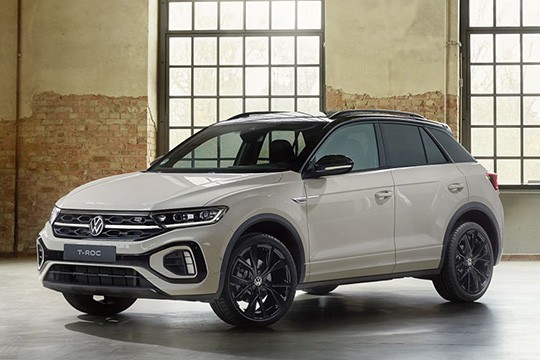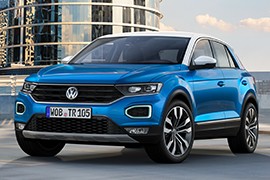VOLKSWAGEN T-Roc Models/Series Timeline, Specifications & Photos
First production year: 2017
Engines: Gasoline, Diesel
Body style: SUV (Sports Utility Vehicle)
Volkswagen enjoyed great success with its B-segment crossover T-Roc that it introduced in 2017, and in late 2021, it refreshed the lineup for the 2022 model year.
The T-Roc was a darling for those who wanted a vehicle short enough to roam easily in the urban environment. Still, it could also tackle unpaved roads or curbs. Furthermore, the car had running costs similar to any other hatchback, and it was also available with an all-wheel drive system. While the 2017 version didn’t impress in terms of styling, the refreshed version could be optioned with a few tweaks that made it look more appealing. Volkswagen offered the T-Roc in two grades: the Style and the R-Line. While the former still had some design details carried over from the non-facelifted model, the latter looked sportier.
At the front, the 2022 T-Roc featured a new design with a honeycomb mesh grille above the bumper crossed by a chromed horizontal slat. This new element visually connected the standard LED headlights that integrated DRLs that doubled as turn signals. Customers could add the IQ.LIGHT package that added matrix headlamps. The Style trim level looked similar to the non-facelifted version of the T-Roc, while the R-Line had a set of stacked LED lights on the side intakes that flanked the lower A-shaped air intake.
Volkswagen offered the T-Roc with standard 16-inch alloy wheels, but customers could opt for sets of up to 19-inch in size. The R-Line version boasted a set of badges that mimicked exhausts on the front fenders, while all versions were fitted with black moldings around the wheel arches. These made the car look like it had a high ground clearance, which was not entirely true. Finally, at the back, the automaker installed new LED taillights, which were in the same light package as the IQ.LIGHT matrix system.
The cabin was improved significantly with a redesigned instrument cluster. Instead of analog dials, drivers fronted an eight-inch TFT display. As an option, a 12.25-inch screen was available. The standard bucket seats provided some side support, but those fitted with the R-Line package provided not just a better look but also featured higher bolstered areas. Atop the center stack, Volkswagen installed a standard eight-inch touchscreen for the infotainment system, with an option for a 9.2” one. In the back, the split-folding (60/40) bench seat provided enough shoulder room for three passengers, but legroom was limited for the one seated in the middle due to the transmission tunnel.
Volkswagen installed a wide choice of engines in the T-Roc and paired them with either a six-speed manual or a seven-speed (dual-clutch) automatic transmission. Depending on the option, customers could get the car with either front- or all-wheel drive systems.
Volkswagen stepped up its game in the crossover segment in 2017 when it introduced the T-Roc as an alternative for those looking for a Golf with a higher ground clearance.
The SUV and Crossover segment was rising in Europe, and Volkswagen tried to keep up with customers’ demands. Other automakers supplied them with adapted or improved versions that could satisfy them. On the other hand, Volkswagen didn’t want to play light, so it developed a crossover from the ground up to make its buyers happy. Even though the new model was based on the same platform as the seventh generation of the Golf, it was difficult to find any similarities between these two distinct-looking models. The new vehicle, named T-Roc, took its “T” letter from the Tiguan and the Touareg, while the Roc came from “Rock.” While at first sight, it was just a jacked-up hatchback, the automaker said that it was more than that; it was a car ready for adventure.
The T-Roc tried to look tough With a front fascia resembling the Touareg with its broad upper black grille. Its headlights were fitted as standard with halogen bulbs, while the upper trim levels were available with LEDs. The bumper integrated the daytime running lights that doubled as turn signals for the upper trim levels, while the base models featured DRLs and separate blinkers. Lower, on the apron, Volkswagen added fog lamps that flanked a wide air intake that was adorned at its lower side by a trim that looked like an aluminum skid plate.
Volkswagen adorned the car’s profile with black moldings around the wheel arches and the side sills to create the illusion of a vehicle with a high ground clearance. Still, the real value was 18 cm (7.1 inches), which was way better for crawling over curbs than the one offered by any regular hatchback on the market. The automaker offered the car in two grades: Style and Sport. Both were provided with 17-inch alloy wheels but with a different design. At the back, the car featured a raked-forward tailgate, while on the lower side of the bumper, Volkswagen installed a black trim adorned by fake side exhausts and an underbody shield.
Inside, the T-Roc greeted its customers with fabric upholstery on the bolstered front bucket seats. The driver fronted an analog instrument cluster filled with four dials while a display was on the options list. Between the front seats, the automaker installed a center console that housed the gear stick or the gear selector depending on the options, a storage area under the center armrest, the button for the parking brake, and a rotary dial that controlled driving programs. In the back, there was room enough for three passengers on the split-folding (60/40) bench seat. Still, the middle-seated one’s legroom was limited due to the transmission tunnel. The car’s trunk provided 445 liters (15.7 cu-ft.) with the rear seats up, but it could expand to 1,290 liters (45.6 cu-ft.) by folding down the rear bench seat’s backrest completely.
Under the hood, the automaker installed a wide choice of diesel and gasoline engines ranging between 115 PS (113 hp) and 190 PS (187 hp). Customers could get the car with either a six-speed manual or a seven-speed (dual-clutch) automatic, with front- or all-wheel drive systems.

